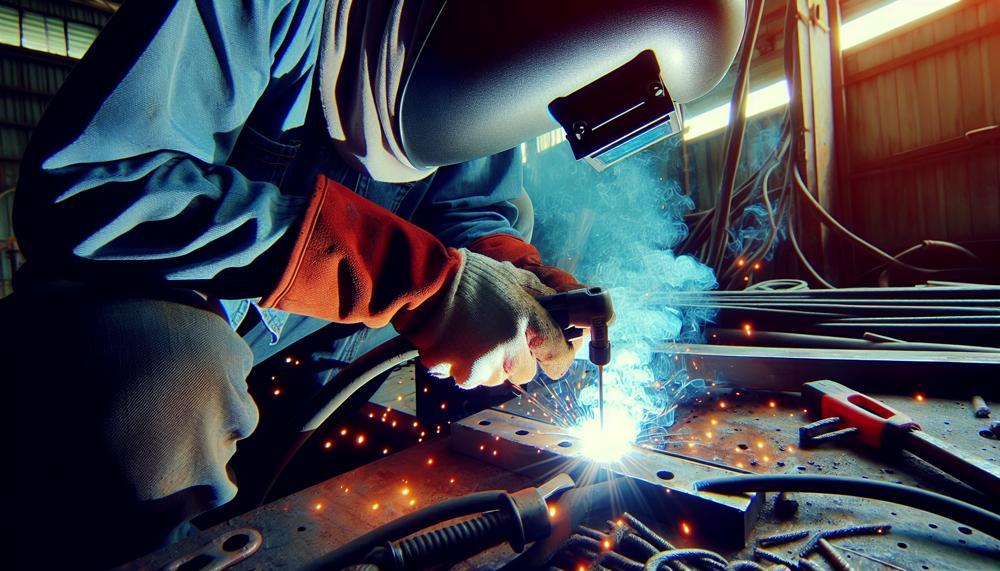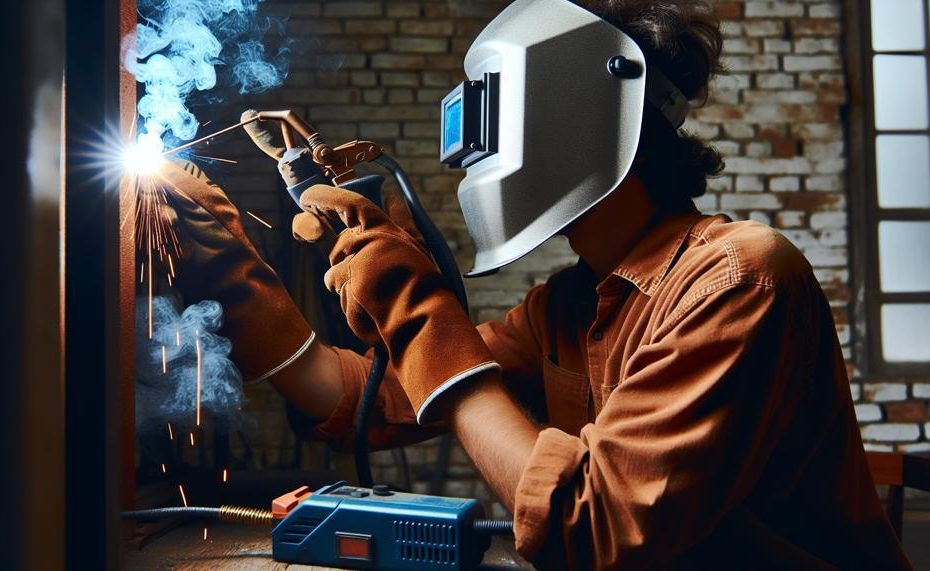Welding is a vital process in various industries, playing a significant role in constructing and manufacturing essential structures and products.
However, this seemingly simple task can come with some severe health hazards if proper safety measures are not followed.
One of the most crucial precautions for welders is wearing a mask, specifically a respirator, to shield against harmful fumes and particles. Unfortunately, many welders overlook this safety measure, either due to discomfort or lack of awareness about the potential consequences.
As a result, they expose themselves to numerous side effects that can have long-lasting impacts on their overall health and well-being.
So, what are the side effects of welding without a mask?
Welding without a mask can cause a number of side effects, including:
Eye damage: Exposure to welding’s optical radiation can cause keratoconjunctivitis, cataracts, and retinal injuries. It can also cause “arc eye,” which is characterized by:
- Pain, ranging from mild pressure to intense pain
- Tearing and reddening of the eyes
- A sensation of “sand in the eye”
- Abnormal sensitivity to light
- Inability to look at light sources
- Abnormal watering of the eyes
- Symptoms typically appear several hours after exposure
- Metal fume fever
- Stomach ulcers
- Kidney damage
- Nervous system damage
- Slivered potatoes or cucumbers: These vegetables possess anti-inflammatory properties that can aid in reducing swelling and alleviating pain. Simply cut thin slices and place them on the affected area for 10-15 minutes.
- Ice packs: Applying a cold compress, such as an ice pack, can provide relief from pain and swelling. Wrap the ice pack in a towel and apply it to the affected area for 10-15 minutes.
- Chamomile or green tea bags: These teas have soothing properties that can help reduce inflammation and relieve discomfort. Place a cooled tea bag over each eye for 10-15 minutes.
- Milk or rose water: Soaking a cotton ball in cold milk or rose water and placing it over the closed eyelids can offer relief from pain and inflammation.
- Castor oil and violet-almond oil: A combination of these oils can effectively soothe the affected area and promote healing. Mix equal parts of both oils and apply a few drops to each eye using a dropper.
Skin damage: Exposure to welding’s UVR can cause acute or chronic skin reactions.
Fume exposure: Prolonged exposure to welding fumes can cause lung damage and various types of cancer, including lung, larynx, and urinary tract. Health effects from certain fumes may include:
Welding can also expose you to toxic metals. Stainless steel contains nickel and chromium, which can cause asthma. Chromium can cause sinus problems and “holes” between the nostrils.
So let’s not compromise on safety and always remember to wear a mask while welding.
Contents
Main Side effects of Welding Without a Mask
Welding without proper safety measures can have severe and long-lasting impacts on your health. The main side effects of welding without a mask include eye damage, burns, and respiratory problems.
These consequences can have a lasting impact on your health if precautions are not taken.
Eye Damage:
Staring directly at the welding light can cause damage to your eyes, leading to pain, redness, and even blindness if done repeatedly. The UV radiation from the welding arc can inflame the cornea and damage the retina, resulting in permanent vision loss.
Wearing a suitable welding helmet is crucial in protecting your eyes from these dangerous rays.
Burns:
The intense heat from welding can cause burns on the skin, including facial hair and eyebrows. These burns can be painful and may result in scarring. Infrared radiation from the welding arc can also penetrate the skin, causing tissue damage.
Wearing protective gear such as gloves and shoulder protection can help prevent burns while welding.
Respiratory Problems:
Inhaling welding fumes without protection can lead to respiratory problems such as throat irritation, coughing, and difficulty breathing.
These fumes contain harmful chemicals and metals that can cause long-term health issues such as cancer or nervous system damage.
Using a respirator while welding can help protect against these fumes.
Long-Term Health Consequences:
Repeated exposure to the side effects of welding without a mask can have long-term consequences for your health.
Eye damage, burns, and respiratory problems can all lead to serious health issues if not properly treated. It is crucial to always wear a welding helmet and take other safety measures to protect yourself while welding.
Prevention:
To avoid these harmful effects, it is essential to take proper precautions while welding.
Wearing a welding helmet, gloves, and respirator is crucial in protecting against UV radiation, burns, and fumes. Seeking medical attention for any eye damage is vital in preventing infection and promoting healing. By following safety measures, you can prevent long-term health consequences and continue welding safely.
Other Side Effects
It is crucial to protect yourself while welding, as there are several long-term effects that can have serious impacts on your health if proper precautions are not taken. Eye damage, burns, and respiratory problems are among the most significant consequences of welding without a mask.
The intense light produced by the welding arc can cause temporary symptoms like dizziness and redness, but prolonged exposure can result in permanent vision loss and even blindness.
This is because the light can cause damage to the retina, which is responsible for transmitting visual information to the brain. To prevent eye damage, always wear a welding helmet with a darkened lens that protects your eyes from the intense light.
Aside from eye damage, welding without a mask can also cause severe burns on the skin. The intense heat generated by the welding arc can easily burn unprotected skin, leading to painful blisters and scarring. Wearing protective clothing and gloves while welding is crucial to avoid these burns.
Furthermore, respiratory problems are also a long-term effect of welding without a mask. The smoke produced during welding contains toxic fumes and particles that can be harmful if inhaled for extended periods of time.
Prolonged exposure to these fumes can lead to lung or larynx cancer. To protect against these effects, it is essential to wear a respirator while welding.
How to prevent health damages
To ensure the prevention of health damages caused by welding without a mask, it is vital to prioritize safety measures and utilize appropriate protective gear.
These measures include wearing a welding mask, working in well-ventilated areas, and educating workers on the hazards of welding without proper protection.
| 1. | Always wear a high-quality welding mask during the welding process | – This will safeguard your eyes from the bright welding light, preventing potential permanent eye damage. |
| 2. | Ensure that the mask fits snugly and adequately covers your entire face | – A properly fitting mask offers maximum protection against harmful UV radiation and toxic fumes. |
| 3. | Choose a top-of-the-line mask with suitable filters for the specific type of welding being performed | – Different types of welding may require different filters to protect against specific fumes or particles. |
| 4. | Routinely inspect and replace worn or damaged masks | – Worn or damaged masks may not provide adequate protection, so it is crucial to check and replace them as needed. |
| 5. | Take regular breaks and limit exposure to welding fumes | – This will help minimize the amount of fumes you inhale and give your body time to recover. |
| 6. | Work in well-ventilated areas or use exhaust systems to eliminate fumes | – Proper ventilation greatly reduces the amount of fumes in the air, creating a safer environment for welding. |
| 7. | Implement safety protocols, such as rotating workers, to reduce individual exposure | – By rotating workers, individual exposure to welding fumes can be minimized and spread out among the team. |
| 8. | Educate workers on the hazards of welding without a mask and provide training on proper safety measures | – It is crucial for all workers to understand the risks associated with welding without a mask and how to protect themselves. |
Remember, welding without a mask can have severe consequences for your health. It is essential to take necessary precautions and utilize suitable protective gear to prevent any potential health damages.
Related Questions
Welding is a potentially dangerous profession that exposes workers to various hazards, including toxic fumes, intense heat, and bright light. To ensure their safety, welders must take critical safety measures, such as wearing a mask or respirator. Neglecting to wear a mask while welding can have serious long-term health effects.
The most common long-term health effects of welding without a mask include eye damage, respiratory problems, lung cancer, skin conditions, and neurological disorders. These health issues can significantly impact a person’s quality of life and ability to work.
| Health Effects | Description | Possible Consequences |
| Eye Damage | Exposing the eyes to UV radiation from welding can lead to cataracts, retinal damage, and vision loss. | Permanent vision loss or impairment |
| Respiratory Problems | Inhaling welding fumes can cause lung diseases such as bronchitis and asthma. | Chronic respiratory issues, difficulty breathing |
| Lung Cancer | Prolonged exposure to welding fumes has been linked to an increased risk of lung cancer. | Potentially life-threatening illness |
| Skin Conditions | Skin contact with welding sparks and hot metal can result in burns, rashes, and skin irritation. | Scarring, skin infections, discomfort |
| Neurological Disorders | Exposure to manganese in welding fumes has been linked to neurological disorders such as Parkinson’s disease. | Impaired motor skills, tremors, cognitive decline |
To prevent these long-term health effects, it is crucial for welders to wear a mask while working. The mask acts as a barrier against harmful fumes and particles, protecting the eyes, lungs, and skin.
In addition to wearing a mask, it is also important to work in a well-ventilated area and take frequent breaks to allow the body to recover from exposure. Employers should also educate workers on the importance of wearing a mask and provide proper training on how to select and use the correct mask for their specific job.
What happens if you look at a welding light?
When welding, it is essential to protect your eyes from the intense light emitted. Without proper protection, you are at risk of developing harmful eye conditions such as welder’s flash, arc eyes, and blue light hazard. These conditions can cause discomfort, temporary vision loss, and even permanent vision damage. To avoid these negative effects, welders must prioritize their eye safety by wearing suitable eye protection and taking necessary precautions.
Welder’s flash, also known as photokeratitis, is like a sunburn of the eye caused by exposure to intense welding light. This can result in redness, irritation, and extreme sensitivity to light.
Additionally, prolonged exposure without protection can lead to arc eyes, which is an inflammation of the clear tissue over the eyeball or cornea. This condition can cause severe discomfort and temporary vision loss.
Moreover, long-term exposure to welding light can increase the risk of developing blue light hazard, macular degeneration, and cataracts. These are serious eye conditions that can lead to permanent vision loss if left untreated.
The intense brightness of the welding light can also cause temporary blindness and fatigue, affecting a welder’s ability to work safely and efficiently.
How do you treat welder’s flash at home?
There are various home remedies that can be effective in treating welder’s flash, including:

Also Read: Is It Safe To Weld A Frame?
Conclusion
In summary, the consequences of welding without a mask are not to be taken lightly.
The potential harm that can be inflicted on one’s eyes, skin, and respiratory system is significant and can have lasting effects on a person’s health. As professionals in the welding industry or individuals who frequently encounter welding processes, it is our responsibility to prioritize safety by wearing a mask.
This simple yet crucial precaution can greatly impact our overall well-being and prevent long-term health complications such as lung cancer.





